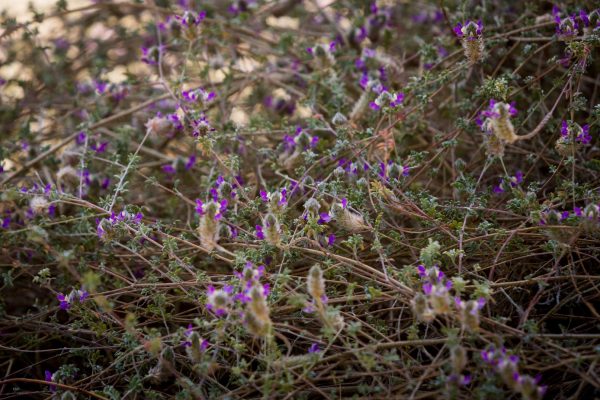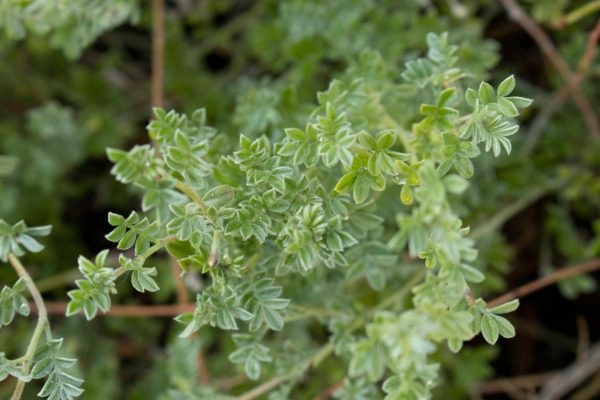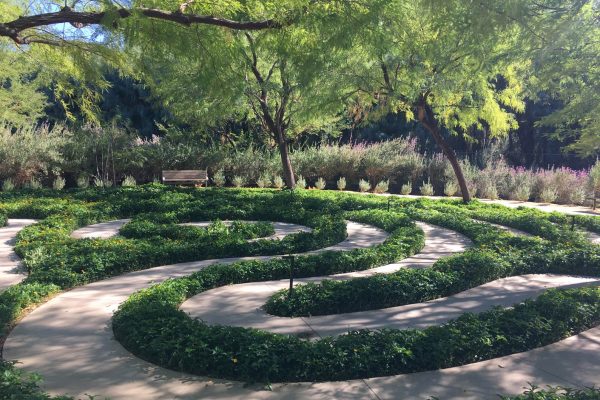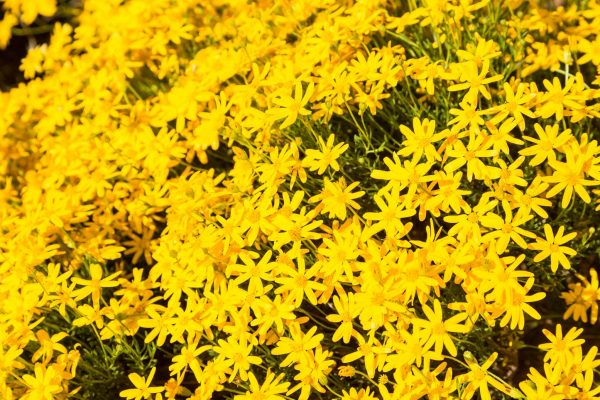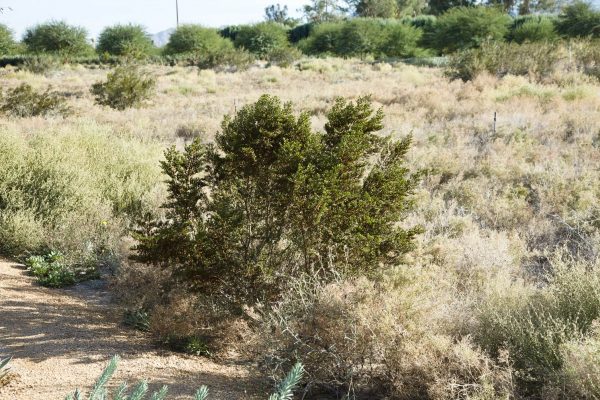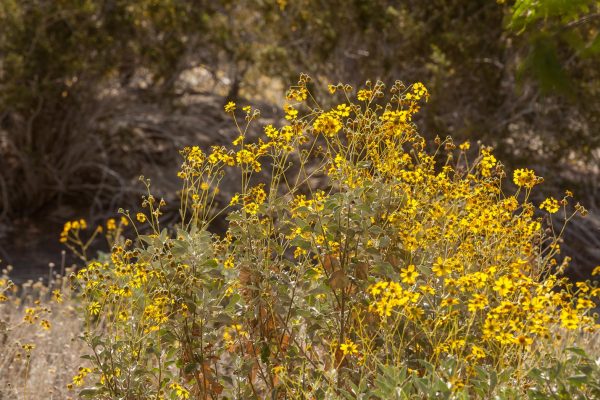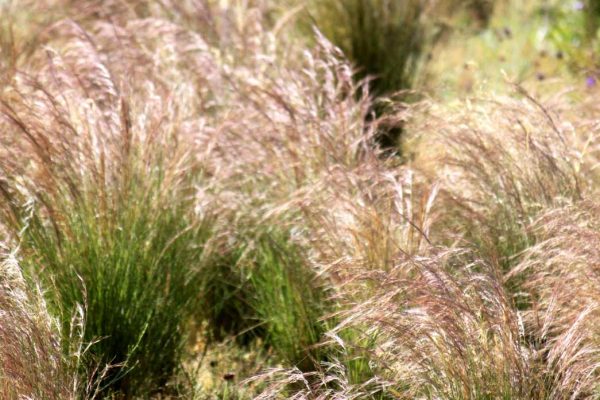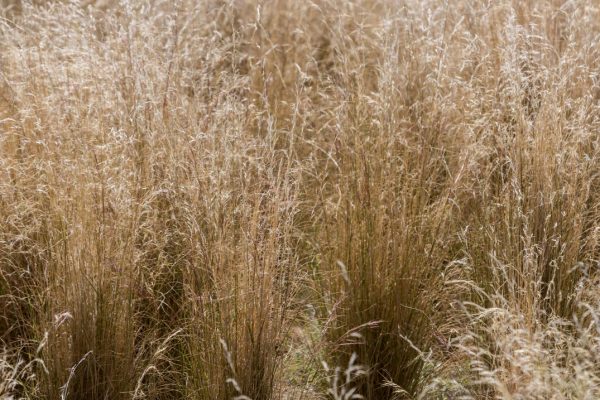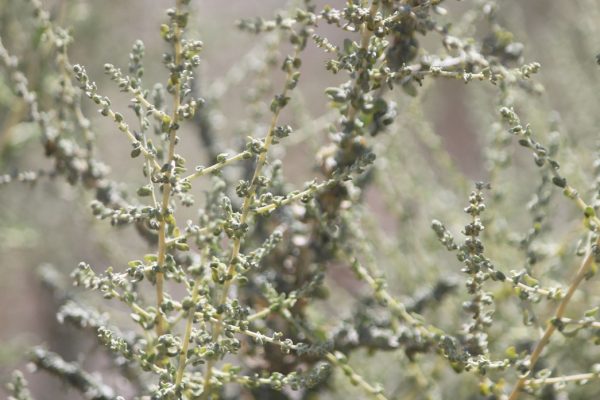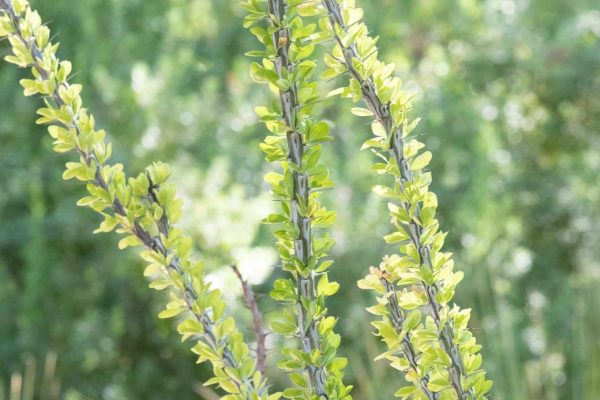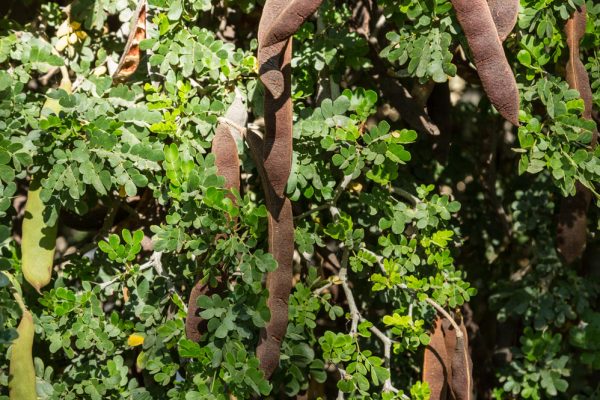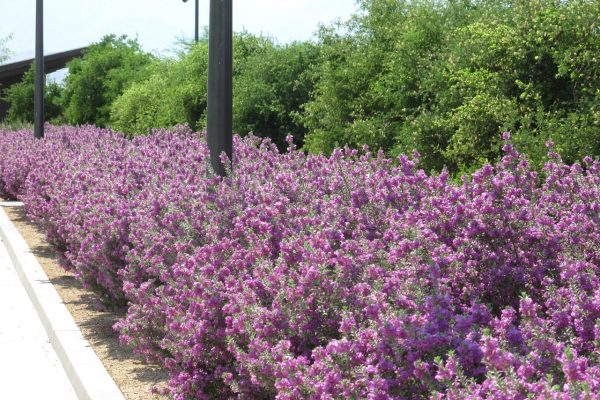
Leucophyllum is the genus for a group of hardy desert shrubs. Most people know it from the common name Texas Ranger or Texas Sage, though it is not a Salvia. Years of commercial cultivation has created a variety of sizes and colors that guarantee a visual variation for almost every desert garden. It blooms in ranges of deep purple to violet and periwinkle, and its fuzzy leaves range from green to silver-gray. Even its size can vary from large shrubs, reaching 6 feet, to smaller compact shrubs.
Sunnylands initially installed six specimens of Leucophyllum spp., but over the years, there have been a few species that triumphed in the gardens. They were the most pest resistant and stood out in color and form. We have reduced the original six to three highlighted species. They are distributed throughout the gardens and can be identified by leaf and/or bloom. The three are, by common name: Green Cloud, Heavenly Cloud, and Sierra Bouquet. They are grouped together here under their genus Leucophyllum, so that their visual features are easy to compare when standing in the gardens.
GREEN CLOUD (Leucophyllum frutescens ‘Green Cloud’)
Green foliage with purple flowers
HEAVENLY CLOUD (Leucophyllum x. ‘Heavenly Cloud’)
Green foliage with bright purple flowers
SIERRA BOUQUET (Leucophyllum pruinosum ‘Sierra Bouquet’)
Gray foliage with periwinkle flowers

This member of the pea family is a shrub that spreads, forming low-mounding hedges with small, fuzzy, silver-green leaves. It’s a popular choice for ground cover in difficult locations like slopes or medians as it can handle full sun and reflected heat. Though its stems can get woody, it often grows back over those sections creating some cover habitat for wildlife. It requires well-drained soil.
Its blooms are small stalks with fuzzy, purple flowers.
Trailing Indigo Bush is native to Texas.
Tested for a couple years in the labyrinth, it was determined not to be a good fit and was replaced with the current Wedelia (Sphagneticola trilobata). It is still used around the wildflower field.
A LOOK ALIKE: At Sunnylands we have two similar species in the the Dalea genus. This offers a choice based on preference for bloom color of purple or yellow. This other species is known as Sierra Gold (Dalea capetata). It can be distinguished by its leaves, which are more of a bright green, and its yellow flower blooms.
Sierra Gold is a trailing groundcover planted along the entry drive and around the performance circle. It was not part of the original planting list, and was added a few years after opening in 2012.
LOOK ALIKE: It grows similarly to Trailing Indigo Bush, which was part of the original plant list installed prior to 2012. Both species are great choices for hot or reflected heat locations and slopes. The choice comes down to whether there is a preference for the true green and yellow flowers of Sierra Gold or the gray-green leaves and purple flowers of the Trailing Indigo Bush.
Native to Coahuila, Mexico.
Wedelia is the low groundcover that trails around the labyrinth. Its low-spreading nature and deep, glossy green leaves are highlighted by small stems with bright yellow daisy-like flowers.
This is reminiscent of the Angelita Daisy that was the original plant in the labyrinth. It did not do well, and neither did the Trailing Indigo Bush that followed.
The Wedelia seems to be thriving in that space. This exemplifies the multiple micro-climates that can occur in an arid space where differing levels of shade and other ecological challenges can mean the difference between a plant thriving in one spot and declining in another.
Native to Mexico, Central America, and the Caribbean, it is invasive in the neo-tropics.
The ground under the Palo Verde trees that ring the Great Lawn is one of the most challenging parts of the garden to cultivate. Moving from sun to shade around the circle, it’s difficult in the low desert climate to find a groundcover that is consistent from full sun to full shade and meets the color aesthetic required for the gardens.
Prior to Damianita, Green Santolina was in this space but it did not do well. Damianita, though not perfect, has done better. In full sun it thrives and creates a solid mound of yellow, daisy-like flowers on a low-mounding green hedge. The shade is a challenge, and in areas where there is full shade, the blooms are much less. That being said, this trailing species has done well overall and is enjoyed by visitors.
The one species of shrub that was here before Sunnylands was developed and left undisturbed in the wildflower field is Creosote. These are the largest shrubs that you can see in the field with small resinous wax-coated leaves. They have a wet scent reminiscent of rain on the desert.
Native to Mexico, as the climate became warmer and drier, the Creosote moved north, arriving in our area less than 20,000 years ago, which is relatively recent. Since arriving, it has filled a niche with more than 20 species of bees as its major pollinators. It is also food for the Chuckwalla, Desert Iguana, and Black-tailed Jackrabbit, though the jackrabbit will only select Creosote if other more palatable options are not available. The leaves are quite bitter.
There are significant ethnobotanical connections to this plant, and some medicinal uses are being researched today.

Brittlebush, a member of the sunflower family, is a medium desert shrub with fuzzy, silver-green leaves that is common along desert roads and medians. It is an extremely durable desert native. The fuzzy coating on the leaves is a desert adaptation that provides protection from the sun, allows for temperature regulation, and helps capture moisture—a strategy that contributes to its durability. At Sunnylands, it can be found in the wildflower field. The name Brittlebush comes from its stems, which are woody and easily broken. It is easily cultivated, grows quickly, and will expand to about 5 feet in height and can spread its branches to a 5-foot span.
It blooms in late winter and early spring with yellow daisy-like flowers, growing from small stems in clusters that look like they are floating above the leaves.
The range for Brittlebush extends through the Sonora Desert, warmer regions of the Mojave, and in some coastal areas of southern California. In Mexico, it is in Baja California, Baja California Sur, Sonora, Sinaloa, and Hidalgo.
Purple Threeawn is a native perennial bunch grass of North America, but is short lived. It lasts longer than an annual, but not as long as other perennials, depending on care. It spreads by seed and can overwhelm a space if not controlled. It is very drought tolerant.
It has a very soft, feathery look. The stalk is tinted purple and moves in waves in the breeze. It is a striking bunch grass and softens the look of the desert wildflower fields, providing background for wildflowers.
It is native across the southern United States.
Indian ricegrass is a bunch grass, which means it grows as a cluster and is not a spreading grass like turf. It has narrow, rolled leaf blades and is topped with clusters of flowers and seedpods. This cool-season perennial is one of three bunch grasses in the wildflower field that serve as important larval hosts for pollinators, and in sandy soil or scrub, provides stabilization for the sand. It can survive in a variety of habitats and clay soils, although it has a preference for sandy soils. The empty seedpods catch the light and create a glowing effect in bright sun.
The plant is a North American native, with a range extending from southern California up through British Columbia and Alberta and east of the Cascades to Texas and northeastern Mexico.
This desert shrub is widespread in desert habitats and does best in alkaline plains. Salt Bush can tolerate soil conditions that other desert natives cannot. It does well with Creosote, but is sometimes found in pure stands with few to no other species. It has a unique adaptation to eliminate the high salt content in desert soil. The hairs on the leaves excrete the salts onto the plant surface. This not only removes the salt from within the plant, but the excreted salt then creates a sunblock on the plant surface. It gives Salt Bush a gray appearance.
It blooms with clusters of cream-colored flowers. This is one plant that requires both a male and female plant for pollination.
It is native to the southwestern United States and northern Mexico.

Ocotillo is a spotlight specimen at Sunnylands and is planted sparingly throughout the gardens in a few mixed-bed locations. There are no single specimen beds that contain only this plant. Its tall stems with significant spines confuse visitors unfamiliar with Ocotillo. They are often unsure if this is a skeleton of a long gone plant or possibly a dead cactus. Shortly after spring begins, Ocotillo will show their true colors. The spines are an indication of the leafing out that will come after spring rains and are the leftover leaf stem from previous seasons.
The plant produces scarlet blooms during a season that can last until fall. The blooms will appear at the tips of the stalks, attracting migrating hummingbirds and orioles. When the season has ended, the leaves and blooms will drop, but the green of the stalk will allow the Ocotillo to gather nutrients through photosynthesis until the next period of rain.
In the wild, stalks will reach up to 20 feet, but they normally top out at 10 feet in cultivated gardens. Ocotillo is easy to grow with few requirements other than well-drained soil and full sun.
Texas Ebony is easy to spot as it creates the tall hedge that surrounds the Center & Gardens. Its zigzagging branch structure is one of its most interesting features and makes it uniquely striking. Planting locations should be carefully selected as its branches are covered in long, rigid thorns, making it virtually impossible to infiltrate.
Like many desert trees, its leaves are small and glossy, which assist it in reducing water loss through transpiration. In spring, it fills with fragrant, light cream-colored flowers. The woody seedpods that follow the blooms are large and can remain on the tree for up to a year. When mature, the pods twist open to scatter their seeds. Though the pods and seeds can create litter, it is deciduous (leaves shed just once a year) in most places so leaf litter is of less concern.

